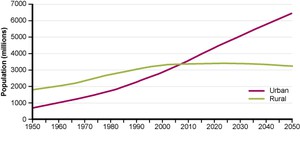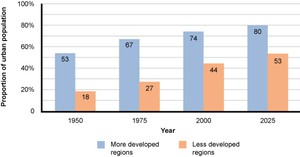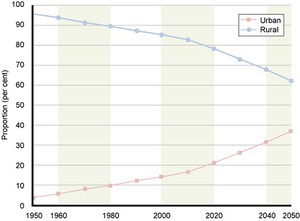Urbanisation trends
In Study Session 2 you learned about the overall trend in global population growth. Most of this increase is taking place in urban areas. Urbanisation is an increase in the number of people living in towns and cities. Urbanisation occurs mainly because people move from rural areas to urban areas and it results in growth in the size of the urban population and the extent of urban areas. These changes in population lead to other changes in land use, economic activity and culture. Historically, urbanisation has been associated with significant economic and social transformations. For example, urban living is linked with higher levels of literacy and education, better health, lower fertility and a longer life expectancy, greater access to social services and enhanced opportunities for cultural and political participation (UNDESA, 2014). However, urbanisation also has disadvantages caused by rapid and unplanned urban growth resulting in poor infrastructures such as inadequate housing, water and sanitation, transport and health care services.
Global trends in urbanisation
In 1960, the global urban population was 34% of the total; however, by 2014 the urban population accounted for 54% of the total and continues to grow. By 2050 the proportion living in urban areas is expected to reach 66% (UNDESA, 2014). Figure 5.1 shows the change in the rural and urban populations of the world from 1950 through to projected figures up to the year 2050.

Figure 5.1 Urban and rural population of the world, 1950–2050. (UNDESA, 2014)
From Figure 5.1, in which year did the number of people living in urban areas first exceed the number living in rural areas?
The two lines cross at about 2007 or 2008. This is when urban first exceeded rural population.
The process of urbanisation affects all sizes of settlements, so villages gradually grow to become small towns, smaller towns become larger towns, and large towns become cities. This trend has led to the growth of mega-cities. A mega-city is an urban area of greater than ten million people. Rapid expansion of city borders, driven by increases in population and infrastructure development, leads to the expansion of city borders that spread out and swallow up neighbouring urban areas to form mega-cities. In 1970, there were only three mega-cities across the globe, but by the year 2000, the number had risen to 17 and by 2030, 24 more mega-cities will be added (see Figure 5.2).

Figure 5.2 The top mega-cities in the world in 1970, 2000 and 2030. (UNDESA, 2014)
From Figure 5.2, in Africa how many mega-cities are predicted to exist by 2030 and how many have already existed since the year 2000?
Six mega-cities are predicted to exist in Africa by the year 2030 – Luanda (Angola), Lagos (Nigeria), Johannesburg (South Africa), Kinshasa (Democratic Republic of Congo), Dar es Salaam (Tanzania) and Cairo (Egypt). There is one mega-city, Cairo, which has had a population of more than 10 million since 2000.
The global trend in urbanisation is not the same in all parts of the world. Asia and Africa currently have the highest rates of urbanisation. Figure 5.3 shows a comparison of trends in more or less developed regions of the world.

Figure 5.3 Trends in urban population growth, comparing more and less developed regions. The graph shows the proportion of the total population living in urban areas.
In Figure 5.3, how would you describe the trends in urban growth in more and less developed regions during this century?
The growth of urban populations in less developed regions is increasing at a faster rate than developed regions. In 2000, in more developed parts of the world 76% of the population lived in urban areas and a small increase to 83% is forecast by 2030. In less developed regions, there was a much smaller proportion living in urban areas in 2000 (only 40%) but this is expected to increase significantly to 56% by 2030.
Urbanisation in Ethiopia
Ethiopia is one of the least urbanised countries in the world today, and only 18% of its population lives in urban areas (JMP, 2014). In common with many other developing countries, however, this pattern is changing (Figure 5.4). Ethiopia’s urban growth rate is more than 4.0% per year, which places it among the highest in Africa and the world (MWUD, 2007).

Figure 5.4 Changing proportion of urban and rural population in Ethiopia from 1950 to 2050 (estimated from 2014 onwards). (UNDESA, 2014)
The rapid increase in urban populations has meant that peri-urban areas are growing much more quickly than formal urban centres. Peri-urban areas are those areas immediately around a town or city. They are areas in transition from countryside to city (rural to urban), often with undeveloped infrastructure, where health and sanitation services are under pressure and where the natural environment is at risk of degradation.
Defining the boundaries of urban, peri-urban and rural areas is not straightforward. They do not neatly separate themselves by lines on a map. On the contrary, the sprawling nature of urban development means that the areas merge into each other. The lack of a clear boundary can make it difficult to assess the size of towns by their population or geographical area. However, judgements have to be made and, for planning and administrative purposes, data on population size are collected. Table 5.1 shows the number of towns and cities in Ethiopia by population in 2007, the most recently published data.
Table 5.1 Numbers and sizes of urban settlements in Ethiopia. (Adapted from MWUD, 2007)
| Population of urban settlement | Number |
| Up to 2,000 | 171 |
| 2,000 to 4,999 | 339 |
| 5,000 to 19,999 | 310 |
| 20,000 to 49,999 | 79 |
| 50,000 to 99,999 | 14 |
| 100,000 to 200,000 | 8 |
| Above 200,000 | 4 |
| Total | 925 |
Of the four cities with a population of more than 200,000, by far the largest is Addis Ababa. In 2007, the population of Addis Ababa was more than 3 million, which amounted to about 25% of Ethiopia’s urban population (MWUD, 2007). The next-largest city, Dire Dawa, had only 293,000 occupants at that time. The impacts of urbanisation are generally much more evident in the capital than in other towns and cities.